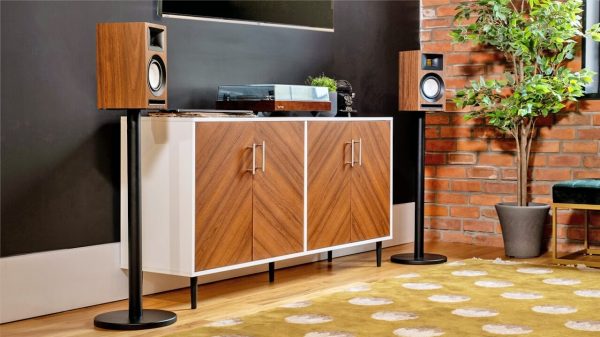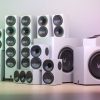Japan-based Sharp with support from its principal owner, Taiwan-based Foxconn, appears to be poised to reinvigorate its current meager presence in the U.S. TV market with two interesting entries.
At the 2023 CES, Sharp exhibited a 120-inch 4K XLED TV prototype in addition to their announcement that they will have a line of XLED TVs, and new OLED TVs for its Roku TV product line for the U.S. market.
XLED TV

If you remember your history, XLED is not a new TV technology. Similar to the ULED marketing label used by Hisense and previously used by Vizio until 2019, Sharp’s XLED label refers to an LCD-based TV that employs several technologies to optimize image quality.
Tip: AQUOS has been Sharp’s traditional marketing label for its mid-to-high-end TV models, similar to how Sony uses the “Bravia” branding to identify its mid-to-high-end TV models. XLED is an add-on label that refers to a specific group of technologies within the AQUOS designation.
The core features of Sharp’s XLED TVs include:
Xtreme Mini-LED
Mini-LED TVs are LCD TVs that use LED backlighting, but in this case, the LED light bulbs are much smaller (typically 2mm or less) than standard-size LEDs used in most LCD TVs.
Since Mini-LEDs are much smaller than LEDs used in most LED backlights for LCD-based TVs, up to several thousand can be used (depending on the TV’s screen size) instead of just dozens (or less) that may be used on standard LED/LCD TV backlight panels.
In the case of Sharp XLED TVs, there are 2,000+ dimming zones (the exact number may vary depending on screen size).
Xtreme Brightness

In addition to the number of mini LEDs and dimming zones, Sharp has implemented the high-brightness capability for its mini-LED backlight panel. Sharp claims that its mini-LED blacklight can deliver up to 6x the peak brightness of most LED/LCD TVs. This is important for features such as HDR, which depend on high brightness output to provide the best possible results. XLED TVs are compatible with HDR10, HLG, and Dolby Vision.
Deep Chroma QD
The third core technology that rounds out Sharp’s XLED technology is the implementation of Quantum Dots.
Quantum Dots are color-sensitive nanocrystals that range from 2 Nanometers (15 atoms) to 7 Nanometers (150 atoms) in size. Quantum Dots are placed on a sheet (Quantum Dot Enhancement Film – QDEF) that is placed between an LED backlight and the LCD Display panel of a TV. With their microscopic size, the number of quantum dots in TV numbers in the millions.
The process of a quantum dot emitting light of a specific color after being struck by a light source is referred to as Quantum Dot Color Conversion (aka QDCC).
This color conversion capability boosts color accuracy and range. For Sharp’s XLED TVs that can be as much as a 20% improvement in color range over LCD-based TVs without Quantum Dots.
Other features (in addition to Sharp’s XLED foundation) include Google TV OS, HDMI 2.1a (eARC, VRR, ALLM), Wi-Fi 6, and Rotating Stand.
Although the 120-inch XLED TV shown at CES was only a prototype, Sharp has indicated that 65, 70, and 75-inch versions are planned to be released to the U.S. market in Spring 2023. There is also a possibility that an 85-inch model will become available later in the year.
XLED TV Sound

AQUOS XLED TVs come with Sharp’s ARSS+ (Around Speaker System) loud speaker. This system is equipped with 10 speakers surrounding the screen and a subwoofer behind the screen. Sound reproduction is enabled by the combination of speakers optimized for high, mid, and low-frequency ranges. Sharp claims that this speaker system will be supported by 85 watts of amplification. Dolby Atmos support is also included.

From Hirofumi Okamoto, BU President of Sharp Corporation’s Smart Display Systems Business Unit: “I am thrilled that Sharp is launching its flagship TV model, AQUOS XLED, to consumers in the U.S. and in other countries and regions. The precise control made possible by its backlight of densely laid mini LEDs and its quantum dot technology enables powerfully expressive brightness and color. The gorgeous images are accompanied by sound that will no doubt give viewers an “excellent experience,” a phrase which inspires the product name.”
Sharp OLED/Roku TV
In conjunction with the AQUOS XLED launch, Sharp plans to introduce six Roku TV models in the U.S. market. Two will be OLED TVs (55 and 65 inches) and four will be non-XLED LCD-based TVs with standard LED backlighting (50, 55, 65, and 75 inches).
Although LCD-based Roku TVs have been available for several years, 2023 will be the first year that select Sharp OLED TVs will be equipped with the Roku OS.
What is interesting about this announcement is that Roku announced a new, premium OLED TV reference design, available to all Roku TV partners (Sharp is a Roku TV Partner). If Sharp is using Roku’s reference design, then it means that the TV meets both Sharp’s and Roku’s technical standards. More details are forthcoming.
Tip: All OLED panels used by Sharp and Roku, as well as other TV brands, are made by the LG Display Company. Sharp has been selling OLED TV models in Japan and other select markets for several years.
Price and Availability for Sharp’s 2023 TV line are still forthcoming.
Related Reading






























Robert Zohn
January 19, 2023 at 7:08 pm
Thank you for your excellent coverage of Sharp’s new 2023 flagship AQUOS XLED 4K HDR QD MiniLED TVs and Sharp’s new 0223 OLED TVs!
Sharp’s new AQUOA XLED series was my favorite MiniLED TV series at CES.